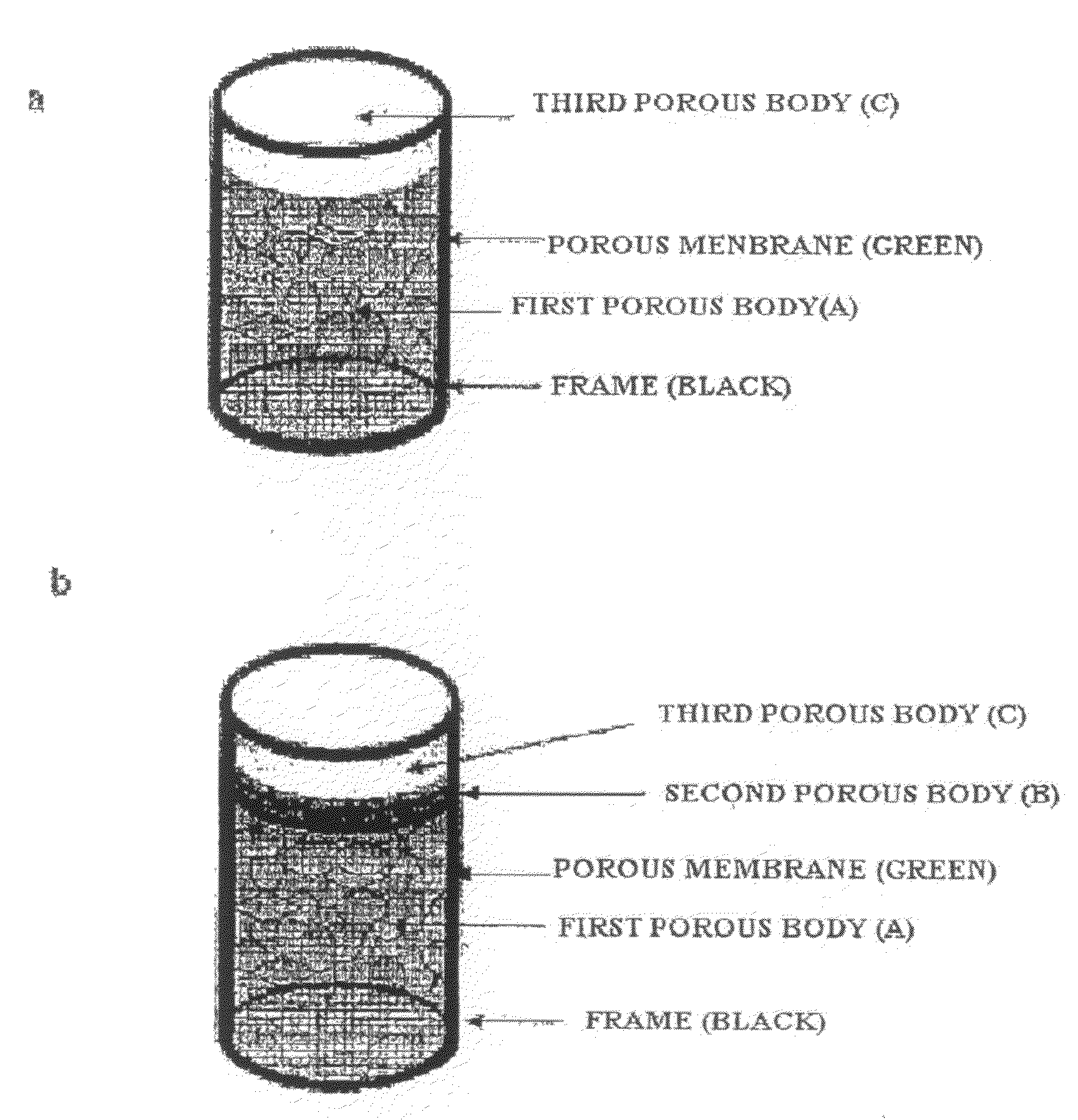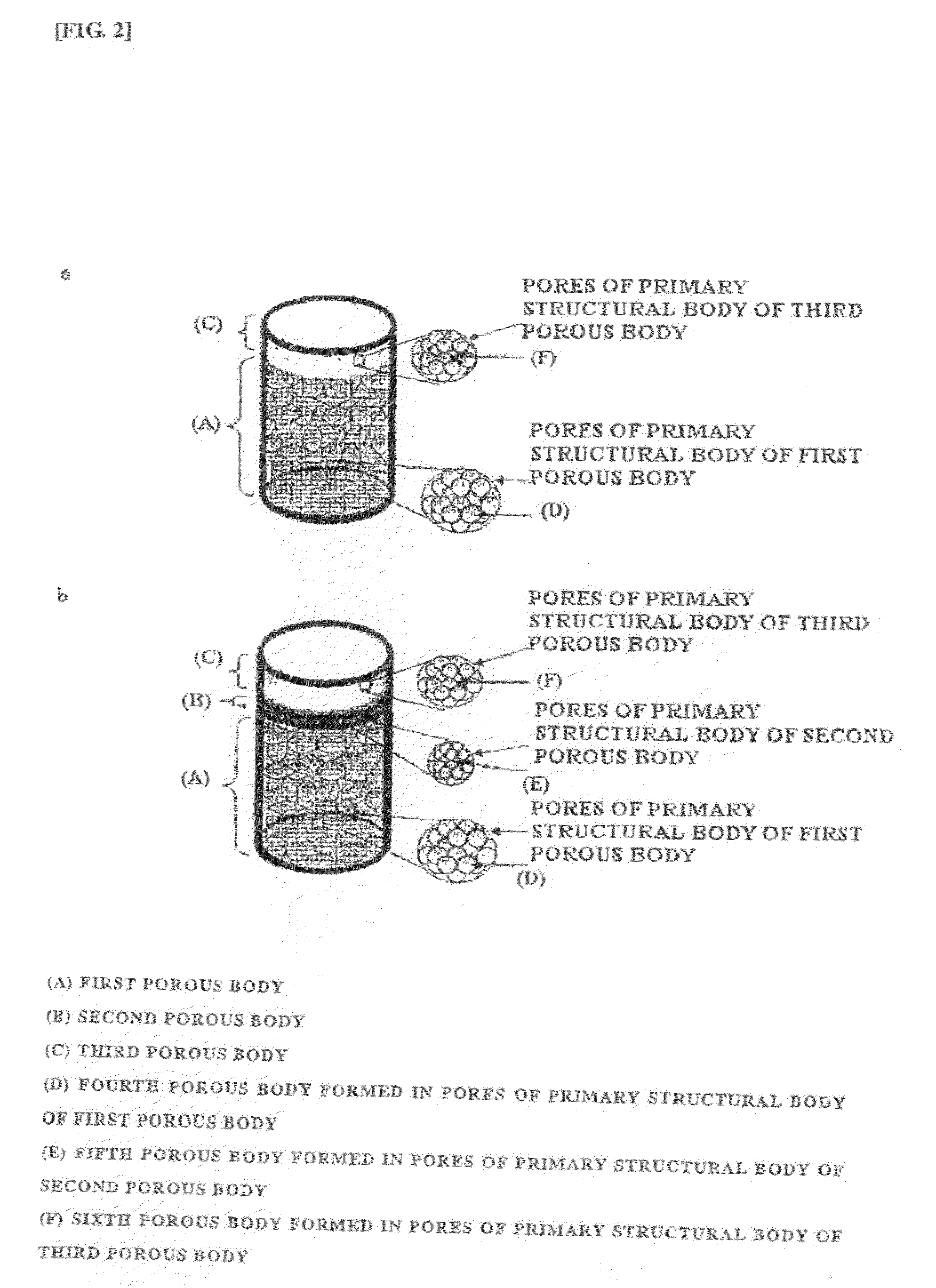Porous Scaffold, Method of Producing the Same and Method of Using the Porous Scaffold
a porous scaffold and scaffolding technology, applied in the field of porous scaffolds, can solve the problems of insufficient function, insufficient rejection response due to immunologic response, wear, loosening, breakage, etc., and achieve the effect of efficiently seeding the cells and accelerating the regeneration of the tissu
- Summary
- Abstract
- Description
- Claims
- Application Information
AI Technical Summary
Benefits of technology
Problems solved by technology
Method used
Image
Examples
example 1
[0108]As one example, a porous body having a frame formed from a polyethylene cylinder frame and a nylon mesh and a PLGA-collagen composite sponge / collagen sponge formed of a composite sponge (PLGA-collagen composite sponge) part of a copolymer (PLGA) of lactic acid and glycolic acid and a porcine skin-derived pepsin solubilized type I collagen which is a bioabsorbable natural polymer and a porcine skin-derived pepsin solubilized type I collagen sponge part was prepared, wherein the PLGA-collagen composite sponge / collagen sponge bad a layered structure and was introduced into the frame.
[0109]The nylon mesh having pores each having a diameter of 2 μm was adhered by heat to a bottom face and an inner surface of the polyethylene cylinder frame having an inner diameter of 6 mm to produce a frame-like structure as a framework of a porous scaffold. The thus-produced framework was washed with an alkaline water and rinsed with a ultrapure water, followed by drying.
[0110]Particles of sodium ...
example 2
[0115]As one example, a porous body having a frame formed from a polyethylene cylinder frame and a nylon mesh and a sponge of a porcine type I atelocollagen which is a bioabsorbable natural polymer was prepared, wherein the sponge was introduced into the frame.
[0116]The nylon mesh having pores each having a diameter of 2 μm was adhered by heat to a bottom face and an inner surface of the polyethylene cylinder frame having an inner diameter of 6 mm to produce the frame as a framework of a porous scaffold. The thus-produced framework was washed with an alkaline water and rinsed with a ultrapure water, followed by drying.
[0117]The thus-produced framework was impregnated with a porcine skin-derived pepsin solubilized type I collagen acid aqueous solution and left in a vacuum state under a reduced pressure that does not freeze the aqueous solution to defoam the framework and to fill the framework with the collagen aqueous solution. The framework filled with the collagen aqueous water was...
example 3
[0120]With the use of the porous body prepared by Example 2, regeneration of a cartilage tissue by culturing human bone marrow-derived mesenchymal stem cells was performed.
[0121]Passage culture of human born marrow-derived mesenchymal stem cells purchased from Cambrex (Cambrex BioScience Walkersville, Inc.) was performed twice at a temperature of 37° C. and under a 5%-CO2 atmosphere in a proliferation medium purchased from Cambrex (Cambrex BioScience Walkersville, Inc.) (a basic medium for mesenchymal stem cells to which a 10%-fetal bovine serum, penicillin / streptomycin, and L-glutamine were added). The bone marrow cells after the passage cultures were detached and collected by using 0.025%-trypsin / 0.01%-EDTA / PBS(−) to prepare 1.5×106 cells / mL of a bone marrow cell suspension solution. Next, 1,000 μl of the cell suspension solution was added by dropping to the three-dimensional porous material that was sterilized with an ethylene oxide gas to seed the cells. After the seeding, the s...
PUM
| Property | Measurement | Unit |
|---|---|---|
| porosity | aaaaa | aaaaa |
| porosity | aaaaa | aaaaa |
| pore size | aaaaa | aaaaa |
Abstract
Description
Claims
Application Information
 Login to View More
Login to View More - R&D
- Intellectual Property
- Life Sciences
- Materials
- Tech Scout
- Unparalleled Data Quality
- Higher Quality Content
- 60% Fewer Hallucinations
Browse by: Latest US Patents, China's latest patents, Technical Efficacy Thesaurus, Application Domain, Technology Topic, Popular Technical Reports.
© 2025 PatSnap. All rights reserved.Legal|Privacy policy|Modern Slavery Act Transparency Statement|Sitemap|About US| Contact US: help@patsnap.com



